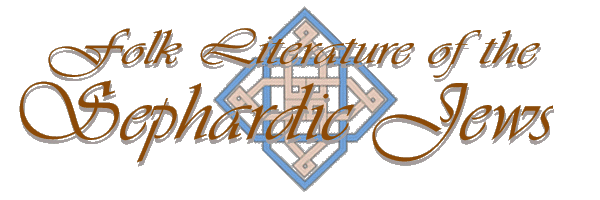Oral Literature of the Hispanic World
Samuel G. Armistead, Faculty Research Lecture, 1998, University of California, Davis
Dedication and Acknowledgments
The Nature of the Pan-Hispanic Ballad
The 700-Year Oral Tradition of the Pan-Hispanic Ballad: A Case Study
Enter Judeo-Spanish: A Living Matrix of Pan-Hispanic Ballad Traditions
Medieval Epic and the Ballad: An Example
The Invention of Tradition: A Case of "False Memory"
Creative Cultural Fusions: "Orientalizing" the Ballad Melody
Enter Judeo-Spanish: A Living Matrix of Pan-Hispanic Ballad Traditions
In 1957, I left Princeton to accept a position as Instructor at UCLA. On arrival in Los Angeles, I met Joseph Silverman, who was also teaching in the Spanish Department. My training at Princeton was in Medieval Spanish literature and in Comparative Romance Linguistics. Joe Silverman was a specialist in Renaissance and Classical Spanish literature, covering the period roughly from 1500 to 1650. Joe was particularly interested in Spain's Jewish heritage. What had Spanish Jews, some of whom had converted to Christianity and had remained in Spain, after the banishment of Jews in 1492; what had these converted Jews, conversos or New Christians, as they were called, what had they contributed to Spanish culture? After all, such figures as Sta. Teresa de Jesús (St. Theresa), St. John of the Cross, and many other writers, even, very probably, Cervantes himself, could be counted among the New Christians or their descendants.
At the time of my arrival in Los Angeles, there was--and there still is--a large community of Spanish-speaking Jews, immigrants from Greece and Turkey, who had arrived in America during the early years of this century. These people are known as Sephardim, Sephardic Jews, from the Biblical place name, Sepharad, in the book of Obediah, which, in medieval times, came to be used in Hebrew as a name for Spain, and Sephardim for its inhabitants. The Sephardic Jews of Eastern Mediterranean lands had retained their distinctive form of Spanish--Judeo-Spanish--which preserved many archaic features of the Spanish language, as it was spoken at the time of their ancestors' exile, almost five centuries before. These people also retained a still very vital, living tradition of oral poetry, much of which likewise dated back to 15th-century Spanish origins.
Given such a constellation of circumstances, and given our particular interests, it seems now almost inevitable that Joseph Silverman, as a Golden Age specialist, particularly interested in Hispano-Judaic problems, and that I, as a Hispano-Medievalist, particularly interested in oral poetry, should have embarked then on a collaborative project that was to develop into a long-range enterprise, involving international travels and a life-long commitment.
As soon as we started our field work, we came to realize that, if our research was to produce an accurate reflection of the Judeo-Spanish tradition, we would have to enlist the collaboration of an ethnomusicologist. Texts and music are inseparably entwined. So it was that Israel J. Katz, who had been doing field work of his own in Israel, joined our team in 1959.
The result of our collaborative work has been, for me, a most enjoyable, indeed a thoroughly marvelous--international--adventure. From 1957 through 1960, we explored the Sephardic immigrant communities of the U.S.: Los Angeles, San Francisco, Seattle, and New York. These American Sephardic communities consisted, mostly, of immigrants from the Balkans and the Eastern Mediterranean. But the Judeo-Spanish language and Judeo-Spanish oral literature have also survived in a number of communities in North Africa--in Morocco and in Algeria. So, if our collection was to be truly representative, we would also have to go to North Africa.
And this we did: In 1962, the three of us spent a summer in Morocco, visiting every one of the Hispano-Jewish communities: seven towns in all. In 1963, I returned alone to Morocco to do further field work. There remained also the challenge of investigating how the ballad tradition (and the language) had survived in Israel. In 1978, the three of us traveled to Israel, visiting eight different communities and collecting over two hundred texts and fragments of Judeo-Spanish traditional ballads, as well as other forms of folk literature, which were, of course, also collected during our previous field trips.
In all, our Sephardic collection now embodies just under 1500 ballad texts, representing some 190 different narrative types, sung or recited by Sephardic Jews from Bosnia, Macedonia, Bulgaria, Greece, Turkey, Israel, and Morocco. The collection also includes abundant examples of other traditional genres: lyric poetry, folktales, proverbs, and riddles. Three volumes of our projected 16-volume edition have already been published; four more volumes have been completed and are currently being prepared for publication by U.C. Press. I am currently working on Vol. VIII.

 Software development and hosting is currently provided by the
Software development and hosting is currently provided by the